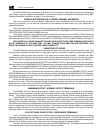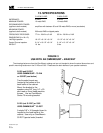
S-125/S-125C/S-85/S-85C
page 7
LEFT SPEAKER RIGHT SPEAKER
LINE X - Y SHOULD EQUAL
LINE A - B. (LINE A - B APPEARS
LONGER IN THIS DIAGRAM DUE
TO AN OPTICAL ILLUSION).
B
If the speakers are on a television set or shelves, locate them on the front edge, so there is no flat surface directly
in front of them. If the speakers will sit close to walls or other large objects, leave as much space as possible between
the speaker and the object. Ideally, your Satellites will be several feet from the nearest surface, but in most rooms
compromise is necessary.
C. SEPARATION BETWEEN LEFT AND RIGHT SPEAKERS
Here is a formula for achieving the ideal left to right stereo imaging. Think of a triangle formed by the locations
of the Left and Right speakers and your listening position. Ideally, the subtended angle formed should be between 45
and 50 degrees. Roughly, this means that the Left and Right speakers should be separated by about the same distance
that you are sitting back from the speakers. In other words, if the distance from your listening position to the point directly
between the speakers is 10 feet, place the speakers so their centers are 10 feet apart. See Figure 2 above.
The length of line A - B should be about the same as the length of line X - Y. (They may not seem to be the same
in this diagram due to an optical illusion).
Try to follow the formula as close as you can. You can fine tune the placement by listening to a source with an
image (such as a vocalist) centered between the speakers. When listening in stereo (no Center Channel speaker),
move the speakers closer together or farther apart in small increments until you hear the sharpest and most cohesive
image, especially in the phantom center. You may also want to angle (or "toe-in") the speakers slightly. This often
improves the sharpness of the stereo image, reduces room colorations, and provides a wider seating area. The angled
front baffles of your Satellites also provide this benefit.
6. HOME THEATRE USAGE
TIMBRE-MATCHING
One of the most important factors in achieving excellent Home Theatre performance is timbre-matching. On film
soundtracks, specific sounds are often moved from left to right or from front to back in the room. When the speakers
reproducing these sounds have dissimilar characteristics, there will be an audible discontinuity when the sound shifts
from one speaker to another.
Timbre-matched speakers have very similar tonal characteristics and sound, which come from three critical
elements: similar or identical drivers; similar or identical crossovers; and similar or identical frequency response. In
full M&K systems, these elements have been addressed. You can be assured that the system can achieve the full
potential of Home Theatre sound.
XY
A
FIGURE 2
SEPARATION BETWEEN LEFT & RIGHT SPEAKERS














